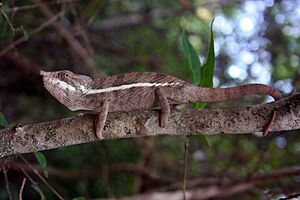Angel's chameleon facts for kids
Quick facts for kids Angel's chameleon |
|
|---|---|
 |
|
| Anjavy Forest, Madagascar | |
| Conservation status | |
| Scientific classification | |
| Genus: |
Furcifer
|
| Species: |
angeli
|
 |
|
| Synonyms | |
|
|
The Angel's chameleon (scientific name: Furcifer angeli) is a special type of chameleon. It's a kind of lizard that belongs to the Chamaeleonidae family. This chameleon lives only in Madagascar. Two scientists, Édouard-Raoul Brygoo and Charles Antoine Domergue, first described it in 1968.
Contents
What's in a Name?
The second part of its scientific name, angeli, honors a French scientist named Fernand Angel. He studied reptiles and amphibians.
Where Does It Live?
The Angel's chameleon is found only on the island of Madagascar. You can find it in the dry forests in the northwest part of the country. It has been seen in places like Bongolava and near Namoroka National Park.
This chameleon also lives near Ambohibola and on the coast near Antsanitia. It prefers to live in trees in dry forests. These chameleons are active during the day. They are usually found at heights between 40 and 300 meters (about 130 to 980 feet) above sea level.
How Is It Doing?
The International Union for Conservation of Nature (IUCN) lists the Angel's chameleon as "Least Concern". This means it's not currently in danger of disappearing. It lives across a large area, estimated to be about 31,506 square kilometers (12,165 square miles).
Even though it prefers untouched forests, it can also live near roads and towns. We don't know exactly how many Angel's chameleons there are. However, their numbers seem to be stable. The biggest danger to this chameleon is when its forest home is destroyed. This can happen because of illegal logging, slash-and-burn farming, or wildfires.
What Does It Look Like?
The Angel's chameleon looks a bit like a "drably colored" version of the Panther chameleon (Furcifer pardalis). It often has a white stripe running down each side of its body. You can tell it apart from the similar Furcifer lateralis because the Angel's chameleon has a small spike at the front of its head.
How It Got Its Name
When it was first discovered in 1968, scientists Brygoo and Domergue named it Chamaeleo angeli. Later, it was moved to a different group of chameleons called Furcifer. That's why its full scientific name is now Furcifer angeli. It's also known as "Angel's chameleon" to honor the French scientist Fernand Angel.


